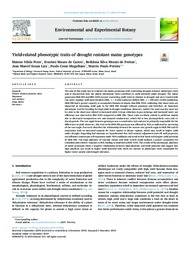Yield-related phenotypic traits of drought resistant maize genotypes.
Yield-related phenotypic traits of drought resistant maize genotypes.
Author(s): PIRES, M. V.; CASTRO, E. M. de; FREITAS, B. S. M. de; LIRA, J. M. S.; MAGALHAES, P. C.; PEREIRA, M. P.
Summary: The aim of this study was to evaluate two maize genotypes with contrasting drought-resistant phenotypic traits and to characterize how the plastic phenotypic traits contribute to yield potential under drought. The maize genotypes DKB 390 and BRS 1010 present contrasting yield traits in relation to drought and were treated with two water regimes: well-watered plant (WW, ??2 kPa) and water deficit (WD, ??100 kPa). In WD conditions, DKB 390 had a greater capacity to accumulate biomass in shoots than BRS 1010, indicating that shoot traits are important in increasing yield gain in the DKB 390 drought tolerant genotype and therefore, an important phenotypic trait for breeding for high yield in drought conditions. However, neither the total root dry mass nor its ratio to the shoot was related to increased yield. A large reduction in gas exchange and increased water use efficiency was observed in BRS 1010 compared to DKB 390. These traits are likely related to yield loss mainly due to decreased transpiration rate and stomatal conductance, which led to low photosynthetic rates and reduced growth. The root angle between genotypes was a constitutive trait and can be primarily responsible for the differences in yield. However, this trait in the DKB 390 genotype was affected by WD, as indicated by narrowing of the root angle. Our work describes the relationship between the narrow root growth angle in DKB 390 and its association with an increased capacity for water uptake in deeper regions, which may result in higher yield under drought. Regarding leaf anatomy we hypothesized that both osmotic adjustment and cell wall properties can influence anisotropic cell expansion under WD conditions and result in leaf tissue with higher yield potential in DKB 390. The high plasticity of vascular tissues and wide vessels could indicate a greater propensity for embolism and a slower response to WD, leading to yield loss in BRS 1010. The results of the phenotypic plasticity of maize genotypes show a negative relationship between high plasticity and yield potential and suggest that high plasticity can result in higher yield potential only when are present in phenotypic traits responsible for higher water uptake and drought tolerance.
Publication year: 2020
Types of publication: Journal article
Unit: Embrapa Maize & Sorghum
Keywords: Anatomia foliar, Déficit hídrico, Genótipo, Milho, Resistência a Seca
Observation
Some of Embrapa's publications are published as ePub files. To read them, use or download one of the following free software options to your computer or mobile device. Android: Google Play Books; IOS: iBooks; Windows and Linux: Calibre.
Access other publications
Access the Agricultural Research Database (BDPA) to consult Embrapa's full library collection and records.
Visit Embrapa Bookstore to purchase books and other publications sold by Embrapa.

